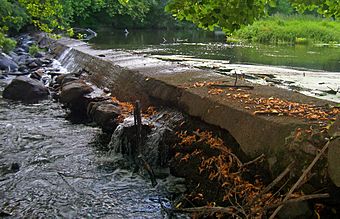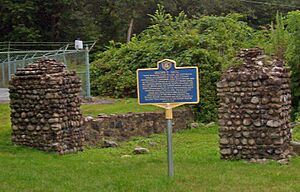Sloat's Dam and Mill Pond facts for kids
Quick facts for kids |
|
|
Sloat's Dam and Mill Pond
|
|

View west across dam, 2008
|
|
| Location | Sloatsburg, NY |
|---|---|
| Area | 15 acres (6.1 ha) |
| Built | 1792 |
| Architect | Isaac Sloat |
| NRHP reference No. | 00000344 |
| Added to NRHP | 2000 |
Sloat's Dam and Mill Pond is a cool historical spot in Sloatsburg, New York. It's a long concrete wall, or dam, that holds back the Ramapo River. This creates a big pond called a mill pond.
The dam was first built way back in 1792 by Stephen Sloat. It helped power mills that used the river's water. It was one of the first dams in Rockland County for milling. Today, it's the only one left that's still mostly complete. Even though the mill closed after a fire, the dam is still an important part of history. In 2000, it was added to the National Register of Historic Places.
What is Sloat's Dam and Mill Pond?
The dam, the mill pond, and other old structures are on a 15-acre piece of land. Most of this land is covered by the mill pond itself. The dam is about 200 feet (60 meters) long. It's also about 4 feet (1.1 meters) high at its tallest point.
The dam is made of concrete. This concrete covers the original stone work. At one end of the dam, there's a stone gate. This gate is part of a channel called a mill race. The mill race would direct water to power the mill. The mill pond is a popular place for fishing today.
At the southwest corner of the property, you can see old stone gateposts. These posts were once part of the Brown Estate. This estate owned the mill property a long time ago. You can find them near the train station. There's also a historical marker nearby. These gateposts are a visible reminder of the area's past.
The gateposts didn't directly help the mills work. But they are important because they are very old. Their stonework is similar to other parts of the mill that were fixed up around the same time. Not much is left of the actual mill buildings. Most of them were torn down in the 1960s.
A Look Back: History of Sloat's Dam
Isaac Sloat built the first stone dam in 1792. He was the son of William Sloat, who first settled Sloatsburg. The dam helped power a sawmill and a tannery. Soon, two other millers built dams nearby.
Isaac's son, Jacob Sloat, made the dam stronger in 1815. He added concrete to it. After that, he made the mill bigger to produce textiles, which are fabrics.
The business did very well. It was helped by the nearby New York and Erie Railroad. Jacob expanded the mill many times before he retired in 1851. The Sloatsburg Manufacturing Company took over in 1857. They made the mill even bigger.
In 1878, the company went bankrupt. This was because of a big economic problem called the Panic of 1873. Four years later, a new owner named William McCullough took over. He started making silk at the mill.
Around 1900, the mill became part of a large estate called Cappamore. This estate belonged to Nicholas Brown. The stone gateposts you can see today were built around this time. In 1903, a big flood badly damaged the mill. The flood also destroyed the other two dams in the area. The mill had to close down.
The Ramapo Piece and Dye Works took over in 1907. They made the first big repairs to the mill in almost 100 years. They built the stone gate for the mill race. It was made of cobblestone, just like the gateposts. They also made the dam stronger at this time.
In 1931, the company, now called Ramapo Finishing Company, tore down the older parts of the factory. They kept using the rest of the mill. But in 1955, a big fire seriously damaged it. The next year, the Cappamore estate was torn down. This happened because the New York State Thruway was being built. The remaining mill buildings were leveled in 1966. This was for a new project that was never finished. The mill race was filled in after someone drowned in the water that was left.
The county bought the mill property and some other land by the river later on. The county and the Sloatsburg Historical Society are working together. They want to turn the area into the 45-acre Eleanor Burlingham Memorial Park. This park is mostly for quiet activities like walking. Today, you can find the historical marker at the gateposts. There's also a short walking trail that leads to the dam.


